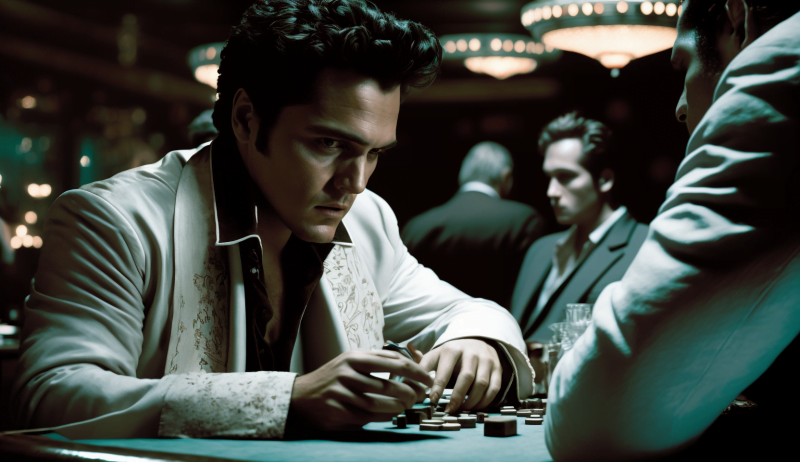Roulette is a popular casino game that involves a spinning wheel with numbered slots and a small ball. Players place bets on where they think the ball will land, with the possibility of winning big payouts. One of the most popular bets in roulette is the color bet, where players bet on either red or black. But what is the longest streak of one color in roulette? Let’s dive into the details.
Understanding Roulette Payouts
Before we get into the details, let’s understand roulette basics. In roulette, the payout for a color bet is even money, meaning that if you bet $10 on red and win, you’ll receive $10 in winnings plus your original $10 bet. This is the same for black, so the odds of winning a color bet are 50/50.
Roulette is a game of chance; every spin is independent of the previous one. The outcome of one spin does not affect the outcome of the next.
What Is The Longest Streak Of One Color In Roulette?
The longest roulette color streak occurred in an American casino in 1943. Red came up 32 consecutive times, making it the longest color streak in history. The odds of this happening are one in more than 10 billion.
Another example of a long winning streak in roulette is attributed to Charles Wells, a gambler who won 23 consecutive times on the same number at the roulette table. This happened at the Monte Carlo Casino in Monaco in the early 1900s. However, this winning streak is based on a specific number rather than a color.
In addition, one person on a forum claimed to have seen a streak of over twenty black numbers in a row and about sixteen red numbers in a row. These streaks are not confirmed and are based on personal accounts.
What Color Wins in Roulette?
Roulette is a game of chance where players bet on which pocket of a spinning wheel a small ball will land in. The pockets are colored in red and black, except the two green pockets labeled 0 and 00 on an American roulette wheel. While there is no definitive answer to the question of which color wins in roulette, we can look at some interesting facts about the colors in the game.
Some players may prefer to bet on red or black. These colors appear equally on the wheel, with 18 pockets each. The red color appears slightly more frequently on the roulette table than the black or green-colored pocket. But the odds of winning a bet on red or black are almost 50/50, with a slight house edge due to the presence of the green pockets.
If you’re interested in betting on a specific color, consider the payoff for a Color Bet, which is a bet on either red or black. As an outside bet, the payoff for a Color Bet is 1 to 1, meaning you’ll win an amount equal to your bet if you’re correct. This makes it a popular and relatively safe betting strategy for players.
No color is guaranteed to win in Roulette. The outcome of each spin is completely random and unpredictable. However, the thrill of the game comes from the possibility of hitting a winning streak and experiencing the rush of excitement that comes with a big win. Whether you bet on red, black, or even green, may the odds be in your favor.
How Often Does Green Hit in Roulette?
Green hits in roulette depend on the type of roulette wheel being played. An American roulette wheel has two green spaces, one marked 0 and one marked 00. 2.6% of the spaces on the wheel are green. On the other hand, a European roulette wheel has only one green space, which is 0. Only 1/37, or approximately 2.7%, of the spaces on the wheel, are green.
The chances of green hitting on any given spin are independent of the previous spins. The probability of the same color showing up 6 times on an American roulette wheel is 1.13%. The probability of seeing the same color appear on successive spins is just over half from one spin to the next. While the odds of green hitting on any given spin are low, each spin is an independent event with its own probabilities.
Roulette streaks Betting strategies
One common betting strategy is the Martingale strategy, which involves doubling the bet after a loss and resetting the stake to the initial amount after a win. While this strategy can be effective in the short term, risks are involved.
Another strategy to consider is the Fibonacci strategy. This works by betting the same amount as the number in the Fibonacci sequence corresponding to the current bet. This strategy can effectively manage losses, as the bets increase slower than in the Martingale strategy. However, the Fibonacci sequence is a mathematical pattern and may not necessarily correspond to the game’s odds.
The “unit size” is another creative strategy you can try. The bet size is based on a percentage of the player’s bankroll. In this strategy, the player adjusts the bet size by one unit depending on whether they have won or lost. For example, if the player wins the first round, they would bet one unit again in the second round. This strategy can help manage risk and potentially maximize profits.
In addition to these strategies, there are many other betting strategies to explore, such as the D’Alembert, James Bond, and Labouchere systems, among others. However, no betting strategy can guarantee a win. Players should always gamble responsibly and within their means.
Is Roulette a Game of Strategy or Luck?
Roulette is a game of chance; the outcome is determined purely by luck. Although many gamblers may argue that roulette involves strategy and decision-making, the truth is that the game is entirely random. Unlike blackjack and poker, roulette has no “right” or “wrong” moves. Players can develop various progressive roulette strategies that involve increasing the size of their bets after each round. However, these strategies are not foolproof and do not guarantee a win.
While luck plays a significant role in roulette, it is not the only factor determining the game’s outcome. Consistently winning at roulette requires a combination of skill and knowledge. Skilled players understand the odds of the game, the different betting options available, and the types of bets that offer the best chance of winning. Additionally, players can develop betting systems that involve placing wagers based on previous outcomes. However, these systems have not been proven effective in increasing a player’s chances of winning.
How Often Do People Win Roulette?
The frequency of winning at roulette greatly varies. It depends on several factors, such as the bet placed, the game’s variation, and overall strategy.
In American Roulette, the chance of winning by betting on a dozen is 31.58%. Every bet has a house edge of 5.26%, except for a top-line bet (5-number bet), which has a house edge of 7.89%. The house edge in American Roulette is 5.26%. Over the long term, the casino will keep about 5.26% of all bets on average. The probability of winning with the same number thrice in a row is 1.
Observing the wheel, noting other players’ wagers, and looking for trends are useful strategies for winning at roulette. You can also look for wheel biases, where the ball repeatedly lands on certain numbers or sections of the wheel.
The potential payout odds in roulette are usually stated in the form of x:1, where x represents the payout, and 1 represents the original bet. For example, a single-number bet offers a payout of 35:1, meaning that a $1 bet could potentially win $35.
The Bottom Line
Ultimately, the key to enjoying roulette is to approach it as a game of chance, not a guaranteed way to make money. While it can be tempting to try and beat the odds or chase after streaks, the reality is that the house always has an edge in roulette. There’s no foolproof strategy that can guarantee a win.
While streaks in roulette are exciting to watch and tempting to place a bet on, they are not a reliable betting strategy. Stick to systems based on sound mathematical principles that don’t rely on streaks or patterns. Remember, in the end, roulette is a game of chance, and no strategy can guarantee a win.




